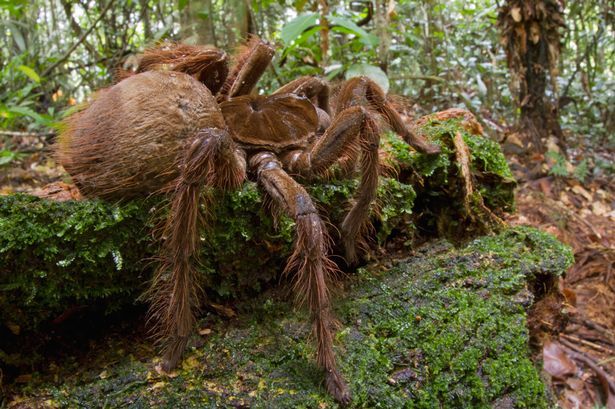
Goliath Bird-eating Spider – https://hgptv.com/wp-content/uploads/2014/10/PAY-Goliath-Bird-eating-Spider.jpg
Spiders are fascinating creatures; while some are creeped out by spiders there are some who are fascinated by them. Assuredly, one of the most enticing spider is found in the lush green rainforest of Guyana – the Goliath birdeater. The Goliath birdeater is the largest spider in the world by mass and size but it is second to the giant huntsman spider by leg-span. Goliath birdeaters can have a leg span of up to 11inches, a body length of up to 4.7inches and can weigh up to 175grams. The Goliath birdeater belongs to the tarantula family Theraphosidae and is also called the Goliath bird-eating spider.
Where Did The Goliath Birdeater Get Its Name From?
The name derived from an early 18th-century copper engraving by Maria Sibylla Merian that shows one eating a hummingbird. Despite the spider’s name, it only rarely preys on birds.
Scientific Classification Of The Goliath Birdeater
- Goliath Birdeater – Theraphosa blondi (Scientific name)
- Kingdom: Animalia
- Phylum: Arthropoda
- Class: Arachnida
- Order: Araneae
- Suborder: Mygalomorphae
- Family: Theraphosidae
- Genus: Theraphosa
- Species: T. blondi
Tip: Birdeaters are one of the few tarantula species that lack tibial spurs, located on the first pair of legs of most adult males.
Habitat Of The Goliath Birdeater
The Goliath birdeater is most noticeable in the Amazon rainforest, the spider is terrestrial, living in deep burrows and is found commonly in marshy or swampy areas. It is a nocturnal species and is native to the upland rainforest regions of northern South America: Suriname, Guyana, French Guiana, northern Brazil and southern Venezuela.
Did You Know? The spider is part of the local cuisine in northeastern South America, prepared by singeing off the urticating hairs and roasting it in banana leaves. The flavor has been described as “shrimplike”.
Reproduction Of The Goliath Birdeater
The females do not eat the males during mating unlike other species of spider/tarantula. Females have an average lifespan of 15 to 25 years and mature in 3 to 6 years. The female lays anywhere from 50 to 200 eggs, which hatch into spiderlings within six to eight weeks. The female spins a web, lays in that web, gathers the web into a ball, and carries it around. Carrying the egg sac makes Goliath birdeaters unique among tarantula species. Males have a lifespan of 3 to 6 years and die soon after mating. They reach sexual maturity at some point between the ages of 3 and 6 years. The longest a male has lived after mating is a year. Colors range from dark to light brown with faint markings on the legs. Birdeaters have hair on their bodies, abdomens, and legs.
Diet Of The Goliath Birdeater
In the wild, its diet consists primarily of other large arthropods, worms and amphibians. Because of its size and opportunistic predatory behavior, it is not uncommon for this species to kill and consume a variety of insects and small terrestrial vertebrates. They have been observed feeding on rodents, frogs, toads, lizards, and even snakes. Despite its name, it is rare for the Goliath birdeater to actually prey on birds.
Fun Facts About The Goliath Birdeater
- Sound – In response to threats, Goliath birdeaters stridulate (the act of producing sound) by rubbing setae on their pedipalps and legs. It can make a hissing sound by rubbing its hairs together, which sounds like pulling Velcro apart and can be heard up to 15 feet away.
- Hair – When threatened they also rub their abdomen with their hind legs and release hairs that are a severe irritant to the skin and mucous membranes. These urticating hairs can be harmful to humans; by rubbing its legs against its abdomen, it produces a cloud of tiny, barbed hairs that get in the eyes and mucous membranes causing extreme pain and itching for days.
- Fangs – Like all tarantulas, this spider has fangs large enough to break the skin of a human and its two-inch-long fangs are strong enough to pierce a mouse’s skull.
- Venom – They carry venom in their fangs and have been known to bite when threatened, but the venom is relatively harmless and its effects are comparable to those of a wasp’s sting.
- Eyes – Even with eight eyes, the Goliath birdeater doesn’t see much. It uses the hairs on its legs and abdomen to sense vibrations on the ground or in the air.
- Molt – Goliath birdeaters molt past maturity, meaning they continually produce new skin and shed old skin, as do snakes. The process by which Goliath birdeaters molt can also be used to regenerate lost limbs.
Watch This
Goliath Birdeater In Guyana
Entomologist and photographer Piotr Naskrecki encountered one while he was on a nighttime stroll in the rainforest of Guyana, and at first he thought it was a small, hairy mammal, such as a possum or a rat. He said, “When I turned on the light, I couldn’t quite understand what I was seeing.’’ A moment later, he realized he was looking not at a brown, furry mammal, but an enormous, puppy-size spider – the Goliath birdeater!
Article References:
- https://en.wikipedia.org/wiki/Goliath_birdeater
- https://nationalzoo.si.edu/animals/goliath-bird-eating-tarantula
- https://www.ranker.com/list/goliath-birdeater-facts/aaron-edwards
- https://www.livescience.com/56525-goliath-birdeater-spider-photos.html






